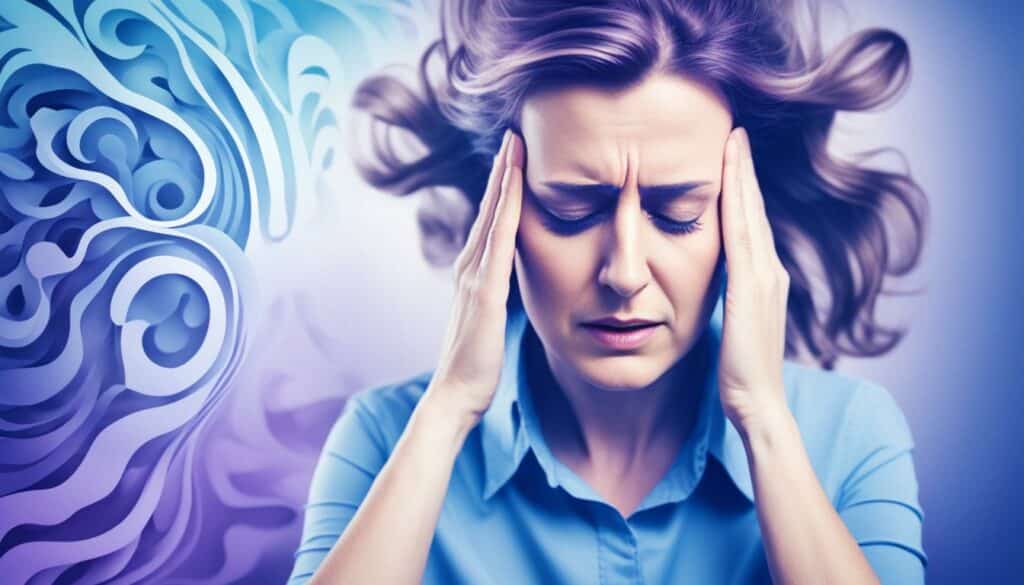
If you experience migraines with pain in the back of your neck, you understand the unique challenges and discomfort they can bring. Not only do these migraines cause intense headaches, but the accompanying neck pain can also make daily activities difficult to manage. It’s important to find relief tips that can alleviate these symptoms and improve your overall well-being.
Key Takeaways:
- Migraines with pain in the back of the neck can cause intense headaches and discomfort.
- Managing these migraines requires effective relief tips to alleviate symptoms.
- By addressing the underlying causes and incorporating lifestyle changes, you can minimize the impact of migraines and neck pain.
- Seeking professional help is vital if migraines with neck pain become chronic or persistent.
- Exploring non-medical treatment options and alternative therapies can complement conventional medical treatments for better relief.
Understanding Migraines and Neck Pain
Before we dive into relief tips, let’s take a moment to understand the connection between migraines and neck pain. By exploring common migraine symptoms, potential causes of neck pain, and available treatments for both conditions, we can gain valuable insights into managing these discomforts effectively.
Common Migraine Symptoms
Migraines are often characterized by intense, throbbing headaches that can last for hours or even days. While the exact cause of migraines remains unknown, certain triggers can provoke these episodes. Some common symptoms associated with migraines include:
- Severe head pain
- Nausea or vomiting
- Sensitivity to light or sound
- Increased sensitivity to smells
Migraines can also be accompanied by neck pain, further exacerbating the discomfort experienced by individuals.
Potential Causes of Neck Pain
Neck pain can have various causes, ranging from muscular issues to underlying medical conditions. When it comes to migraines accompanied by neck pain, some potential causes include:
- Muscle tension and spasms in the neck and shoulder area
- Poor posture or prolonged periods of sitting in the same position
- Stress and anxiety, which can contribute to muscle tension and trigger migraines
- Structural issues in the cervical spine
Available Treatments for Migraines and Neck Pain
Managing migraines and neck pain involves a multifaceted approach that may include various treatment options. Some potential treatments for migraines and neck pain relief include:
- Medications: Over-the-counter pain relievers, prescription medications, and preventive drugs can help alleviate symptoms and reduce the frequency or severity of migraines.
- Lifestyle modifications: Making certain lifestyle changes, such as improving posture, incorporating regular exercise, managing stress levels, and maintaining a healthy sleep routine, can have a positive impact on both migraines and neck pain.
- Physical therapy: Working with a physical therapist can help improve posture, strengthen muscles, and alleviate tension in the neck and shoulder area.
- Alternative therapies: Techniques such as acupuncture, massage therapy, and relaxation exercises may offer relief for migraines and neck pain.
Understanding the relationship between migraines and neck pain is vital for effective management and relief. By addressing migraine symptoms, exploring potential causes of neck pain, and considering available treatment options, individuals can take steps towards a more comfortable and pain-free life.
The Relationship Between Headaches and Neck Pain
Headaches can be a real pain, especially when they are accompanied by neck pain. If you often find yourself experiencing both headaches and neck pain, you’re not alone. These two conditions often go hand in hand, intertwining their discomfort and impact on daily life.
When it comes to chronic neck pain, headaches can be a common symptom. The underlying connection between the two is often attributed to tense muscles in the neck and upper back. The tension in these muscles can lead to both headaches and neck pain, creating a cycle of discomfort that feels never-ending.
Addressing one aspect of this cycle can potentially alleviate the other. For example, focusing on relieving neck muscle tension through stretching or targeted exercises may help reduce the frequency or intensity of headaches. Similarly, using headache relief techniques, such as relaxation exercises or pain medication, can provide temporary relief for neck pain.
It’s essential to recognize the potential interconnection between headaches and neck pain. By understanding this relationship, individuals can take a comprehensive approach to manage both symptoms effectively. Whether it’s through lifestyle changes, targeted therapies, or medical interventions, there are various strategies that can help break the cycle of headaches and neck pain.
“The relationship between headaches and neck pain is complex but addressing one aspect can lead to relief for both symptoms.”
To visualize the relationship between headaches and neck pain, consider the following table:

| Migraine Type | Location of Headache | Associated Neck Pain |
|---|---|---|
| Tension-type headache | Both sides of the head | Mild to moderate neck pain |
| Cervicogenic headache | One side of the head | Moderate to severe neck pain |
| Cluster headache | One side of the head, often around the eye | No associated neck pain |
| Migraine headache | One side or both sides of the head | Mild to severe neck pain |
As shown in the table, different types of headaches may present with varying degrees of neck pain. Understanding these distinctions can help individuals and healthcare professionals identify the appropriate treatment approach based on the specific symptoms.
By recognizing the relationship between headaches and neck pain, individuals can take proactive steps to manage and alleviate these symptoms. Whether it’s through targeted exercises, relaxation techniques, or medical interventions, finding relief is possible.
Common Triggers for Migraines with Neck Pain
If you experience migraines accompanied by neck pain, identifying and avoiding common triggers can help minimize their impact and provide much-needed relief. By understanding what triggers your symptoms, you can take proactive steps to prevent or mitigate migraine attacks. Here are some common triggers to be aware of:
- Stress: Stress is a major trigger for migraines and neck pain. Finding healthy ways to manage stress, such as practicing relaxation techniques or engaging in regular physical activity, can be beneficial.
- Environmental Factors: Certain environmental factors like bright lights, loud noises, or strong odors can trigger migraines. Creating a calm, quiet, and dimly lit environment can help reduce the frequency and severity of your symptoms.
“Identifying and avoiding common migraine triggers can significantly reduce the occurrence of symptoms and improve quality of life.”
- Food and Drinks: Certain foods and drinks, such as aged cheeses, processed meats, chocolate, alcohol, and caffeine, have been known to trigger migraines. Keeping a food diary can help you identify potential triggers and make necessary dietary adjustments.
- Sleep Disturbances: Lack of sleep or irregular sleep patterns can trigger migraines and neck pain. Establishing a consistent sleep routine and creating a sleep-friendly environment can promote better sleep quality and reduce the risk of symptoms.
- Hormonal Changes: Fluctuations in estrogen levels, commonly experienced during menstrual cycles or menopause, can trigger migraines. Consulting with a healthcare professional about hormone therapy or other treatment options may provide relief.
By recognizing these common triggers, you can make targeted lifestyle changes to minimize the occurrence of migraines with neck pain. Additionally, incorporating neck pain remedies into your routine can help alleviate discomfort and support overall well-being.
Managing Neck Pain at Home
When neck pain strikes, there are several simple remedies you can try at home:
- Apply a cold or warm compress to the affected area for 15-20 minutes at a time.
- Practice gentle neck stretches and exercises to improve flexibility and reduce muscle tension.
- Improve posture by maintaining a neutral neck position and avoiding prolonged periods of sitting or standing in the same position.
However, if your migraines and neck pain persist or worsen despite these home remedies, it is essential to seek professional help for a comprehensive evaluation and appropriate treatment.
| Migraine Trigger | Prevention Tips |
|---|---|
| Stress | Practice stress management techniques, such as deep breathing exercises, meditation, or yoga. |
| Environmental Factors | Create a calm and tranquil environment, minimizing exposure to bright lights, loud noises, and strong odors. |
| Food and Drinks | Keep a food diary to identify trigger foods and avoid or limit their consumption. |
| Sleep Disturbances | Establish a consistent sleep routine, prioritize good sleep hygiene, and create a comfortable sleep environment. |
| Hormonal Changes | Discuss hormone therapy or other treatment options with a healthcare professional. |
By being proactive and vigilant about avoiding triggers and incorporating effective remedies, you can significantly reduce the occurrence and impact of migraines with neck pain.
Lifestyle Changes for Migraine and Neck Pain Management
Making certain lifestyle changes can significantly contribute to the management of migraines and neck pain. By incorporating healthy habits and practicing self-care, individuals can reduce the frequency and intensity of migraines and find relief for neck pain.
1. Maintain a Healthy Diet
Eating a well-balanced diet rich in nutrients can support overall health and potentially alleviate migraines and neck pain. Incorporate foods that have anti-inflammatory properties, such as:
- Salmon, which is high in omega-3 fatty acids
- Leafy greens like spinach and kale, which are rich in magnesium
- Turmeric, a spice with powerful anti-inflammatory effects
- Colorful fruits and vegetables, which provide antioxidants
Avoid or limit the consumption of trigger foods, such as processed meats, caffeine, alcohol, and artificial sweeteners, which can exacerbate migraines and neck pain.
2. Engage in Regular Exercise
Physical activity can help improve blood circulation and reduce muscle tension, both of which can contribute to migraine and neck pain relief. Consider incorporating activities such as:
- Llow-impact exercises like walking, swimming, or cycling
- Yoga or Pilates to improve flexibility and promote relaxation
- Strength training to build strong and supportive muscles
Always consult with a healthcare professional before starting a new exercise routine, especially if you have any underlying health conditions.
3. Practice Effective Stress Management
Stress is a common trigger for migraines and can lead to neck pain as well. To effectively manage stress, consider incorporating the following into your routine:
- Mindfulness meditation or deep breathing exercises
- Engaging in hobbies or activities that promote relaxation and joy
- Setting boundaries to prioritize self-care and reduce overwhelm
Remember, finding stress management techniques that work for you may require some trial and error. What works for one person may not work for another.
4. Maintain Good Sleep Habits
Sleep plays a crucial role in managing migraines and neck pain. Adopting good sleep habits can contribute to better overall well-being. Consider the following:
- Establishing a consistent sleep schedule
- Creating a comfortable and conducive sleep environment
- Avoiding stimulating activities before bedtime
- Practicing relaxation techniques to promote better sleep
Getting an adequate amount of quality sleep can help reduce the frequency and severity of migraines and alleviate neck pain.
5. Maintain Proper Posture and Ergonomics
Poor posture and ergonomics can contribute to neck pain and trigger migraines. Be mindful of the following:
- Keep your spine aligned and avoid slouching
- Adjust your work environment to ensure proper ergonomics
- Take regular breaks from prolonged sitting or repetitive tasks
Implementing good posture habits and optimizing your workspace can help prevent neck pain and reduce the occurrence of migraines.
Remember, lifestyle changes take time and consistency to show significant results. It’s essential to be patient with yourself and stay dedicated to these practices to effectively manage migraines and find relief for neck pain.

Non-Medical Treatment Options for Migraines and Neck Pain
While conventional medical treatments play a crucial role in managing migraines and neck pain, there are also non-medical approaches that can effectively complement your treatment plan. By incorporating alternative therapies and techniques, you can find additional relief and improve your overall well-being.
1. Mind-Body Practices
Mind-body practices such as yoga, meditation, and deep breathing exercises can help reduce stress levels and promote relaxation. These practices have been shown to alleviate migraine symptoms and minimize neck pain by calming the mind and gently stretching tense muscles.
2. Acupuncture
Acupuncture, a traditional Chinese medicine practice, involves the insertion of thin needles into specific points on the body. It is believed to help rebalance energy flow and alleviate pain. Many individuals have found acupuncture beneficial in reducing the frequency and intensity of migraines and relieving neck pain.
3. Massage Therapy
Massage therapy can be an effective way to soothe tense muscles, improve circulation, and promote relaxation. Targeted neck and shoulder massages can help relieve pain and tension in these areas, providing relief from migraine symptoms and neck discomfort.
4. Herbal Remedies
Certain herbal remedies have been used for centuries to address pain and promote overall well-being. For migraines and neck pain, herbs such as feverfew, butterbur, and ginger may provide relief. However, it is essential to consult with a healthcare professional before trying any herbal remedies to ensure safety and proper dosage.
5. Relaxation Techniques
Practicing relaxation techniques such as progressive muscle relaxation, guided imagery, or biofeedback can help reduce stress levels and manage migraines and neck pain. By learning to relax the body and calm the mind, you may experience fewer symptoms and an improved sense of well-being.
“Incorporating non-medical treatment options into your migraine and neck pain management plan can provide additional relief and support your overall well-being.” – Dr. Emily Thompson
Remember, it’s essential to consult with a healthcare professional before starting any new treatment, even non-medical ones. They can assess your individual needs and provide personalized guidance on incorporating these treatments into your routine.
| Treatment | Benefits |
|---|---|
| Mind-Body Practices | – Reduces stress levels – Promotes relaxation – Calms the mind – Stretches tense muscles |
| Acupuncture | – Rebalances energy flow – Alleviates pain – Reduces migraine frequency and intensity – Relieves neck pain |
| Massage Therapy | – Soothes tense muscles – Improves circulation – Promotes relaxation – Relieves neck pain and migraines |
| Herbal Remedies | – Provides natural pain relief – May reduce migraine symptoms – Alleviates neck pain |
| Relaxation Techniques | – Reduces stress levels – Manages migraines – Eases neck pain |
Remember, what works for one person may not work for another. It’s essential to explore different options and listen to your body to find the approach that brings you the most relief.
Seeking Professional Help for Migraines and Neck Pain
If you have been experiencing migraines accompanied by neck pain that persist or become chronic, it is crucial to seek professional help. Consulting a healthcare professional can provide you with the guidance and treatment options you need for effective relief.
When should you consider seeing a healthcare professional for your migraines and neck pain? Here are some signs that indicate it may be time to schedule a consultation:
- Frequency and intensity of migraines and neck pain have significantly increased
- Migraines and neck pain are interfering with your daily activities and quality of life
- Over-the-counter medication and home remedies are not providing sufficient relief
- You have concerns about the underlying causes of your migraines and neck pain
By consulting a healthcare professional, you can receive a proper diagnosis and personalized treatment plan tailored to your specific condition. They may recommend a combination of treatments to address both the migraines and neck pain, such as:
| Treatment Options | Explanation |
|---|---|
| Prescription Medication | A healthcare professional may prescribe medication specifically designed to manage migraines and relieve neck pain. These medications can help reduce the frequency, duration, and intensity of migraines while providing relief for neck pain. |
| Physical Therapy | Physical therapy can play a crucial role in treating neck pain associated with migraines. A qualified therapist can help improve posture, strengthen neck and shoulder muscles, and alleviate tension that contributes to migraines and neck pain. |
| Lifestyle Modifications | Your healthcare professional may recommend lifestyle changes, such as stress management techniques, regular exercise, and adequate sleep, that can help prevent migraines and reduce neck pain. |
| Alternative Therapies | Some individuals find relief from migraines and neck pain through alternative therapies such as acupuncture, chiropractic care, and massage. Your healthcare professional can guide you in exploring these options. |
Remember, every individual’s migraines and neck pain may have different underlying causes, so it’s essential to consult a healthcare professional to receive personalized treatment. They will work with you to alleviate your symptoms, improve your quality of life, and help you find long-term relief.
Conclusion
In conclusion, effectively managing migraines with pain in the back of the neck requires a comprehensive approach that addresses both the symptoms and underlying causes. By understanding the intricate relationship between migraines and neck pain, individuals can make informed decisions about their treatment.
Making lifestyle changes is an essential aspect of managing these conditions. Incorporating healthy habits such as regular exercise, maintaining a balanced diet, and managing stress levels can significantly reduce the frequency and severity of migraines and provide relief for neck pain.
Exploring non-medical treatment options can also be beneficial. Techniques like acupuncture, massage therapy, and relaxation exercises have shown promise in alleviating migraines and neck pain. These alternative approaches can complement medical treatments and provide individuals with additional avenues for relief.
However, it is important to recognize that professional help may be necessary for some individuals. If migraines with neck pain persist or worsen, it is crucial to consult a healthcare professional. They can diagnose any underlying conditions and recommend appropriate treatment options to effectively manage the symptoms and improve overall well-being.
